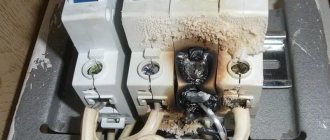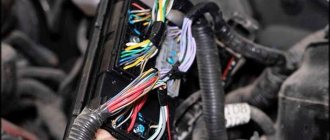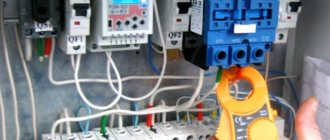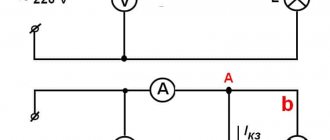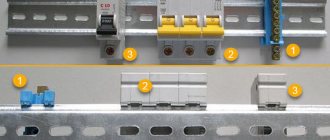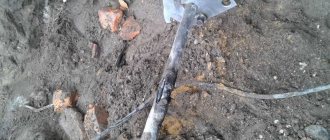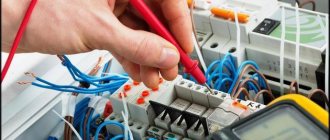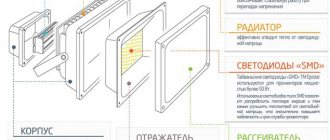Short circuits are often the cause of accidents in electrical networks. They are often a source of fire, the cause of failure of electrical appliances and individual sections of networks. An effective measure in combating the consequences of short circuits is the use of fuses or the use of modern circuit breakers that cut off faulty sections of circuits from the power supply. But then a problem arises: how to find a short circuit on a de-energized wire or device. Finding a fault is always more difficult than eliminating a defect, so some simple ways to detect a short circuit will be discussed in this article.
What is a short circuit
A short circuit (SC) is an abnormal operation of the electrical network. It is characterized by a sharp jump in current up to hundreds and thousands of amperes. The voltage drops to almost zero. This process is short-lived and usually stops when the circuit breaker trips.
Electrical wiring fault
In an ordinary residential apartment or house, the most common phase conductor short circuit to neutral or ground. At enterprises and in various workshops, short circuits between linear conductors are also encountered. This type of closure is called interphase.
Causes of short circuit
To combat negative phenomena, it is necessary, first of all, to find out the cause of their occurrence. To do this, let us define the term “short circuit”.
I am sure that most of you have the answer ready: “A short circuit is when two conductors with a current of different polarity come into contact with each other.” This definition is only partially correct. It does not describe the complete picture of the short circuit. In particular, a short circuit can occur between two phase wires, and not necessarily as a result of them touching.
Figure 1 shows a short circuit diagram of phase conductors.
Fig.1. Phase short circuit
Therefore, the correct answer is: Short circuit is a phenomenon resulting from the connection of two points in a circuit section, causing a condition in which the load resistance is much less than the internal resistance of the current source.
Based on the definition, it becomes clear that the cause of a short circuit can be any situation that leads to a significant decrease in the resistance between conductors with different potentials. For example, breakdown of a diode or other electronic element in the circuit of an electrical device. A short circuit occurs as a result of an erroneous connection of wires (phase to neutral) when installing electrical wiring.
Quite often short circuits are caused by:
- Breakage of wires in power networks under the pressure of strong winds, snow accumulation and other reasons.
- In a home network, the cause of a short circuit is often a faulty electrical wiring or excessive load on certain sections of the electrical network.
- Short circuits occur in electrical equipment, usually due to poor condition of connecting cords, which is caused by careless handling.
- Electricians sometimes have to eliminate the consequences of a short circuit resulting from cable damage during unauthorized excavation work. Unauthorized digging of trenches leads not only to damage to the insulation of wires, but also to short circuits of current-carrying conductors by the excavator bucket.
- Use of electrical wiring for purposes other than its intended purpose. For example, the use of wires intended for internal networks in external electric current transmission lines. Under the influence of sunlight, moisture, and temperature changes, the insulation is destroyed. When water fills the cracks, contact occurs between the wires with the accumulation of electrolytic salts. Sooner or later there will be a short circuit.
- Mechanical damage when a section of electrical wiring is shorted due to damage to the cable by a nail, screw, drill, or as a result of accidental contact with the working part of a construction tool. Such short circuits are typical for hidden electrical wiring.
There are other causes of accidents associated with short circuits, but they are very rare. For example, using electrical outlets with poor contacts. Due to sparking sockets, soot is formed, which settles on plastic parts. During long-term operation, especially if consumers with increased loads are turned on, a layer of soot can short-circuit the wires. The consequences are shown in Figure 2.
Rice. 2. Short circuit caused by a faulty socket
It rarely comes to this, since a short circuit is preceded by the appearance of a pungent smell of burnt wiring, which usually prompts the apartment owner to replace the faulty socket.
Causes of short circuit in wiring
A short circuit does not occur out of the blue. There are always reasons and prerequisites. Some of them are easily predictable, obvious and on the surface. They can be identified many months before a short circuit occurs. Others arise instantly. They cannot be prevented in advance.
The main causes of short circuit are as follows:
- mains voltage surge;
- overheating and melting of insulation;
- aging and wear of wires;
- penetration of dust, dirt and moisture from the air;
- rodents, domestic and wild animals;
- lightning and atmospheric electricity;
- human error.
Wiring in old houses
Mains voltage surge
The standard mains voltage for the CIS countries is 220-230 volts. Rarely is this norm exceeded. The outlet has a voltage of 380 volts or higher. In this case, the protection devices at the substation or directly at the consumer must operate. However, they are not always in good condition and overvoltage “walks” along the wires.
A large potential difference leads to electrical breakdown of the insulation. The process starts with a small leakage current. Subsequently it increases. The breakdown site is heating up. Then the insulation at the point of damage finally loses its dielectric properties and a full short circuit occurs with the formation of an electric arc.
Power surge
Overheating and melting of insulation
Electric current flowing through a conductor leads to heating of the current-carrying conductors. If an acceptable power consumer is connected to the outlet, the cable temperature remains within normal limits. If the current exceeds the rated current, the wire overheats. Over time, the temperature reaches a value at which the insulation melts. The current-carrying conductors remain without a protective layer and touch each other freely. There is a bang, a flash and the short circuit is ready. If the circuit breaker trips, everything will be fine. If not, the wiring will heat up white and the insulation will burn until the circuit is completely broken.
The maximum permissible currents of residential electrical wiring are indicated in the table. The values may differ slightly depending on the installation method (open, in the wall, etc.)
| Wire cross-section, mm2 | Maximum permissible current, A | |
| Copper | Aluminum | |
| 1,5 | 15 | — |
| 2,5 | 21 | 16 |
| 6 | 34 | 24 |
Important! Attention should be paid to bolted wire connections and various terminal blocks. Their contacts are subject to loosening. A loose fastening will inevitably heat up and burn. Usually this problem is recognized by a crackling sound from the shield or a burning smell. The malfunction is typical for old, previously unmaintained equipment.
Aging and wear of wires
Any electrical wiring consists of current-carrying conductors and a layer of insulation. A metal conductor in normal operation can last indefinitely. Insulation is subject to wear and tear. The service life of the protective layer is affected by:
- cable load and temperature;
- laying conditions (open, closed);
- ambient temperature and humidity;
- mechanical stress and vibration;
- cable manufacturing quality.
Service life of wires and cables
Aluminum wires are designed for 15-20 years of service. Copper - 25-30. Then the insulation begins to age, crack and crumble. The conductors remain without a protective layer and are able to touch each other freely. The result will be a short circuit.
Penetration of dust, dirt and moisture from the air
This type of short circuit is common in residential panels and distribution devices. In these sections of the network, the wiring has exposed, non-insulated parts. Over time, dust from the air settles on them. When dry, it does not conduct current well. However, there is a certain percentage of moisture in the air.
Dust settles on terminal blocks, input circuit breakers and other components of the electrical panel. When the layer of dirt becomes thick enough, its resistance drops sharply and electrical breakdown occurs. Water entering the electrical panel can greatly aggravate the situation. For example, in the event of a pipe break or if the shield is located in the open air and is exposed to precipitation.
Rodents, domestic and wild animals
Pets and outdoor animals are often the culprits of short circuits. The four-legged one's teeth itch. The animal begins to chew on the insulation. Even if the pet receives an electric shock and weanes itself off this habit, the protective layer will remain damaged. Moisture will get into the hole in the insulation. This will most likely lead to a short circuit.
Rodents can cause a short circuit
In another case, the four-legged culprit is attracted to the heat coming from cables and busbars. The animal climbs into electrical assemblies, switchboards and switchgear cabinets, then looks for the warmest place. As a rule, these are electrical buses with a voltage of 0.4 kV.
Lightning and atmospheric electricity
Tall buildings, engineering structures, and power line supports are required to be equipped with grounding. One of its tasks is to attract lightning strikes and charges from the atmosphere for their further discharge into the ground.
A simple lightning protection system consists of an iron wire or strip connected between the roof of the building, the reinforcement and the ground. This is usually done for each entrance separately. If you exclude lightning protection, then the discharge can enter the household electrical network. It is not designed for high lightning currents and voltages. Upon impact, electrical breakdown of insulation will occur everywhere. There is a high risk of damage to the protective layer by high voltage and further development of the short circuit.
Lightning protection of a cottage roof
Human error
Even experienced electricians make mistakes. When wiring cables through an apartment network, a person can confuse the wires and connect the phase directly to zero or ground. This usually happens in room junction boxes.
If the phase wire is connected to the neutral wire, then when you try to supply voltage to the apartment, the circuit breaker will trip. Therefore, electrical installation work should be divided into several stages and the correct connection should be checked after each one.
Errors when installing electrical wiring
Basic wiring faults
Here are the types of electrical wiring faults in apartments and houses:
- Insulation damage. As a result of this, a current leak will occur, and if you do not have an RCD in the panel, then electric shock cannot be avoided. Such a breakdown can be eliminated by restoring the integrity of the insulation or simply replacing the damaged area.
- Damage to the current-carrying conductor. It can occur as a result of careless installation or repair work. Aluminum conductors are very fragile, so you need to twist them with a screw clamp as carefully as possible, because if they break, the power will be lost.
- Due to an incorrectly selected core cross-section or poor contact in the strands, insulation melting may occur. Such a malfunction can lead to a fire in a house or apartment. This problem can be resolved by replacing the cable with a more powerful one.
- Failure of household appliances. If your electrical appliances are shocking or you smell a burning smell, it means your household appliances are faulty. In this case, an electric shock or electrical fire may occur.
- Poor contact in places where wires are connected to machines, sockets, or poor contact in twists. In this case, the cores heat up and the insulation melts. And as a result, a fire occurs in the electrical wiring. The malfunction can be eliminated by tightening the clamps or periodically checking all connections.
- Failure of switches and sockets. On average, an electrical product has a service life of no more than 10 years. If the socket is old, then when connecting the plug, overheating may occur, which can cause a fire. If the switch wears out, it simply stops working.
- Burning of the neutral wire in the panel. This is the most dangerous electrical wiring fault. As a result, there may be a danger of electric shock to a person. Such a breakdown can be eliminated only by restoring contact, and the danger can be prevented by installing a voltage control relay.
Consequences of a short circuit
In the event of a short circuit, the circuit breaker must trip. This is usually what happens. And if not, then the wiring quickly overheats, melts and begins to burn. Therefore, short circuit is one of the most common causes of fire. A corresponding warning is also available on the website of the Ministry of Emergency Situations. According to this resource, every day in Russia 125 buildings burn down due to faulty wiring.
Fire due to shorted wiring
Short Circuit Detection Techniques
If the circuit breaker has tripped, then the worst has been avoided. Then the question arises of how to find a short circuit in the apartment wiring. There is no need to panic. There is a chance that you will be able to detect the malfunction yourself without calling a specialist. Finding a short circuit in an apartment is divided into four simple steps:
- Visual inspection.
- Elimination method.
- Detection by sound and smell.
- Use of special measuring instruments.
Visual inspection
It is not a fact that the short circuit point is in the wall. Usually the fault lies on the surface. It can be seen with the naked eye and quickly eliminated.
Extension cords need to be inspected. Especially in places where the cable bends and the plug is connected. Often one wire comes loose and dangles in the air. A phase contact that is not secured by anything can touch the neutral contact and lead to a short circuit. Next are the sockets. Wires can also fall off and end up in the wrong place.
Visual inspection of electrical wiring in a private house
Elimination method
If a simple inspection does not help, you will have to move on to the elimination method. The main thing is to understand why the machine is triggered. It is worth remembering under what circumstances the short circuit occurred. If the embarrassment occurred at the moment when the iron was plugged into the socket, then the problem lies there. If not, you should turn off the household appliances one by one until the circuit breaker stops tripping.
If absolutely all devices are unplugged and the lights are turned off everywhere, then you will have to move on to the next stage. It is important to remember to check devices that are always plugged in (refrigerators, televisions).
Additional Information. You will never find a short circuit that is not there. Old circuit breakers are prone to false trips. That is, there is no short circuit in the wiring, and the machine lives its own life and turns off the apartment for no known reason. Before searching for a short circuit, it would not hurt to make sure that the protection devices are operating adequately and find out for sure why the circuit breaker trips.
Sound and smell detection
When a short circuit occurs, a lot of energy is released. She doesn't leave without a trace. Often in the problem area the wires heat up, the insulation melts, smoke is formed and there is a smell of burning. If the circuit is unstable, then when voltage is applied at the short circuit point, a bright flash with sparks and a bang will occur. Its intensity is such that it is almost impossible not to notice this phenomenon even in hidden wiring.
This and the previous methods require periodic re-switching of the voltage. This, in turn, will lead to a short circuit again. It is advisable to carry out such experiments a minimum number of times and with at least some knowledge and experience of such work. If possible, it is wiser to call a professional electrician. He will most likely come with a multimeter or megger.
Use of special measuring instruments
The method requires electrical engineering education. The closure point is sought using measuring instruments:
- multimeter;
- megohmmeter;
- indicator screwdriver;
These devices allow you to ring the apartment's electrical network and determine in which area there is a point with an abnormally low resistance between the phase and neutral (ground) conductors. The most effective way to find short circuits is a megohmmeter. But it is much safer to use a multimeter in diode testing mode. If a section of wiring with a short circuit is connected to its terminals, the device beeps.
Elimination of short circuit consequences
If the search for the short circuit was successful, then it’s time to exhale and start eliminating it. What to do next depends on the extent of the damage to the electrical wiring. Regardless of the situation, before starting any repair work, you should definitely turn off the power to the apartment and make sure there is no voltage.
It is necessary to assess how much the cable insulation was damaged at the time of the short circuit. If there are swelling, darkening or melting, the wire must be replaced. If possible, it is necessary to assess its condition along its entire length.
Connecting wires in the distribution box using terminal blocks
If the wire covering is in order, then the immediate location of the short circuit is removed. The surviving ends of the current-carrying conductors are stripped and connected using Wago terminal blocks, welding, soldering or crimping. In low-current circuits, you can use regular fast twisting at your own risk. However, the PUE (7th edition, clause 2.1.21) does not provide for and does not approve of this method of connecting cables.
Pipeline heating method
Copper cores twisted in parallel create a constant voltage along the entire length of the electrical cable. The cable heating wire is equipped with a thermoplastic sheath, which provides protection against condensation and evaporation.
The advantages of heating with a self-regulating cable include:
- The ability to automatically reduce the temperature regime in areas with less heat transfer, without changing the temperature of other zones.
- High resistance to voltage surges.
- Permissibility of cutting the cable to the required length.
- Ability to overlap cables for plumbing systems.
The metal braid creates grounding and shielding and protects the elements from mechanical actions. The maximum length that a heating thermal cord has for heating a pipeline is limited to 60-100 m. An external heating cable can increase power when the temperature decreases, and when it increases, it can automatically turn off.
Heating cable is quite expensive
Such a cord for water supply and sewerage is more expensive than a resistive one, but the operating costs are several times lower. The system does not overheat due to heat dissipation regulation. A distinction is made between cable installation outside and inside the pipe.
Preventive measures to prevent short circuits
Most short circuits and the fires they cause can be avoided. To do this, you should follow simple rules:
- Do not overload the electrical wiring with power (current). Select the cable cross-section and lay it in accordance with the requirements of the PUE.
- Periodically inspect the electrical panel, sockets and switches. The smell of burning, smoke, sparking and crackling are harbingers of a short circuit and fire.
- Replace old circuit breakers with new ones. Especially if a revision of the shield has not been carried out since Soviet times.
- If you use fusible plugs at the entrance to the apartment, then under no circumstances place so-called bugs on them. Even if an electrician I know “did this 100 times and everything was fine.” It is best to replace traffic jams with automatic machines.
If you notice that there is a burning smell coming from the electrical panel or switchgear, immediately notify the management company. The actions of the emergency service will be aimed at preventing short circuits and inspecting equipment.
A short circuit is one of those problems that are easier to prevent than to correct the consequences. Any wiring, various devices and panels require periodic inspection by a specialist. Compliance with this rule will ensure long and safe operation of electrical equipment.
If it was not possible to avoid a short circuit, then you need to think about its causes. Wiring that is old, too thin or damaged by animals must be replaced. Damp - dried and further tested by a professional electrician using a megger or more advanced instruments.
